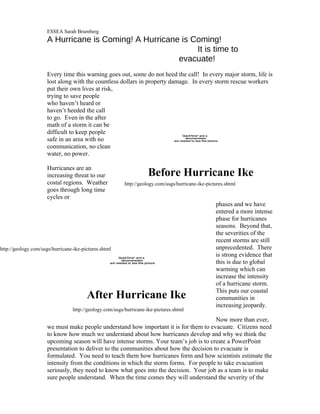
A Hurricane Is Coming Assignment
- 1. ESSEA Sarah Brumberg A Hurricane is Coming! A Hurricane is Coming! It is time to evacuate! Every time this warning goes out, some do not heed the call! In every major storm, life is lost along with the countless dollars in property damage. In every storm rescue workers put their own lives at risk, trying to save people who haven’t heard or haven’t heeded the call to go. Even in the after math of a storm it can be difficult to keep people QuickTimeª and a safe in an area with no decompressor are needed to see this picture. communication, no clean water, no power. Hurricanes are an increasing threat to our Before Hurricane Ike costal regions. Weather http://geology.com/usgs/hurricane-ike-pictures.shtml goes through long time cycles or phases and we have entered a more intense phase for hurricanes seasons. Beyond that, the severities of the recent storms are still http://geology.com/usgs/hurricane-ike-pictures.shtml unprecedented. There QuickTimeª and a is strong evidence that decompressor are needed to see this picture. this is due to global warming which can increase the intensity of a hurricane storm. This puts our coastal After Hurricane Ike communities in increasing jeopardy. http://geology.com/usgs/hurricane-ike-pictures.shtml Now more than ever, we must make people understand how important it is for them to evacuate. Citizens need to know how much we understand about how hurricanes develop and why we think the upcoming season will have intense storms. Your team’s job is to create a PowerPoint presentation to deliver to the communities about how the decision to evacuate is formulated. You need to teach them how hurricanes form and how scientists estimate the intensity from the conditions in which the storm forms. For people to take evacuation seriously, they need to know what goes into the decision. Your job as a team is to make sure people understand. When the time comes they will understand the severity of the
- 2. situation. They will be ready and they will go to safety, keep rescue workers safe as well! Your job is to explore your understanding of hurricanes, collaborate with your teammates, learn through research and discussion, QuickTimeª and a collaborate more decompressor are needed to see this picture. and then communicate your team’s understand through a PowerPoint presentation to a community group. Here are the 6 steps to follow: Read the entire description of the project including the rubric before beginning One: Brainstorm. Every person should first make a write what s/he knows about the following list of questions. Write all the sphere to sphere connections, event to sphere connections and causal chains. As you go, create a list of things you need to know or questions that you have. • What is a hurricane? How are hurricanes created? • What conditions intensify hurricanes? • How do hurricanes move? What happens when they make landfall? Two: Collaborate by brainstorming with your teammates. Do this by sharing your lists with each other. Choose a note-taker and a question-writer. Give a written version of your brainstorm to the note-taker and keep one for yourself. Share you understanding through discussion. How does your ESS analysis compare to others? Try to answer others questions as a group. As you go have the question-writer keep a list of questions the group needs to research. Three: Research by dividing up the research questions between teammates. Research using from the list given or from trusted sites. Answer the questions as fully as you can. Four: Collaborate more by sharing your research and deciding what points and information need to be included in your PowerPoint. Create a list of questions that the group still has which may be extension questions. Reevaluate your group list of connections and chains. Add our new understanding. Five: Create a PowerPoint that describes your scientific understanding of hurricanes development and the effect of interconnectedness of the ES systems. Include what you have learned about the path of hurricanes and development of hurricane intensity. Make
- 3. sure that you use images, charts and /or graphs to help your explanation and hold interest. Also, create a bulleted list of the important information you are including. Share this list with your instructor and the other groups to get feedback to prepare yourselves for the presentation. Give feedback to other groups on their lists. Revise your PowerPoint if needed. Six: Present it to a group of “community members” (This may include parents, school staff and students.) Ask your Audience for feedback. Do they understand how hurricanes are formed? Do they have a sense of how interconnected Does this knowledge help them to understand why evacuation is necessary? Rubric follows Extensions: Wetland extension- What kind of effect do national and local wetland policies have extent of the destruction that hurricanes have on the land? How is local wetland policy influenced by industry? What effect does the upper Mississippi River Basin have on the wetlands and shorelines that are likely to be vulnerable to hurricanes? Websites: Movie- brief overview of what is a hurricane development: http://dsc.discovery.com/videos/hurricane-development.html Straight-forward description of Hurricanes with interactive pieces. Very cool GoogleEarth Hurricane tracker with NASA info. Click around to multiple pages. Lots of info. http://ww2010.atmos.uiuc.edu/(Gh)/guides/mtr/hurr/home.rxml Categorizing Hurricane intensity http://www.cotf.edu/ete/modules/sevweath/swintensity.html from part of a NASA partnered project called Center for Educational Technologies NOAA description of The Saffir-Simpson Hurricane Scale http://www.nhc.noaa.gov/aboutsshs.shtml NG article on the effects of global warming on Hurricanes: http://news.nationalgeographic.com/news/2005/08/0804_050804_hurricanewarming_2.ht ml Useful liks from this page to Global Warming and Hurricanes. GFDL Model Simulations: Atlantic Hurricane Activity. http://www.gfdl.noaa.gov/~tk/glob_warm_hurr.html NOAA scientist study presented. Regular fluctuation of temperatures and hurricanes http://www.aoml.noaa.gov/phod/amo_faq.php Coral like tree rings as evidence of our past (It must be in two lines as seen to connect) http://www.gsajournals.org/perlserv/?request=get-
- 4. abstract&doi=10.1130%2FG24321A.1&ct=1 Hurricane Research Division-Frequently asked questions/Hurricane awareness http://www.aoml.noaa.gov/hrd/tcfaq/tcfaqHED.html Hurricanes general info http://www.fema.gov/kids/hurr.htm Hurricanes...Unleashing Natures Fury, A preparedness guide. Useful generalized list http://www.nws.noaa.gov/om/brochures/hurr.pdf